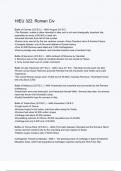HIEU 322: Roman Civ
Battle of Cannae (216 B.C.) - ANS-•August 216 B.C.
•The Romans, unable to allow Hannibal to take such a rich and strategically important site,
assembled an army of 80,000 to meet him.
•Hannibal had less than half of that number
•Roman army was led by the two cautious consuls: Gaius Terentius Varro & Aemilus Paulus.
•Complete disaster- one of the worst defeats in Roman history.
•Over 53,000 Romans were killed and 7,000 Carthaginians.
•Rome's prestige was shattered, and Hannibal claimed most of southern Italy.
Battle of Gerunium (216 B.C.) - ANS-•Ambush of Minucius by Hannibal
2. Minucius was on the verge of complete disaster but was saved by Fabius.
3. Army turned back over to civilian command.
Battle of Lake Trasimene (217 B.C.) - ANS-•June 217 B.C. •Hannibal moved south into Italy
•Roman consul Gaius Flaminius pursued Hannibal into the mountains near Aretzo (and Lake
Trasimene).
•The overall Roman losses were 15,000 (out of 30,000), including Flaminius. •Hannibal's forces
lost only about 2,500.
Battle of Metaurus (207 B.C.) - ANS-•Hasdrubal was surprised and surrounded by the Romans
at Metaurus.
•Hasdrubal's army was destroyed, and Hasdrubal himself killed. •Several days later, his severed
head was thrown into Hannibal's camp.
•Ended Hannibal's hope for success in Italy
Battle of Trebia River (218 B.C.) - ANS-•December 218 B.C.
•Fought south of Ticinus
•Romans hoped to find native, anti-Gaul allies along the Trebia
•Romans had about 42,000 under Longus
•Carthage had about 30,000 soldiers
•Devastating outcome for Rome: 26,000 casualties (out of 42,000)
•Carthage lost only 5,000 (out of 30,000)
Battles of Ticinus River (218 B.C.) - ANS-•First clash between Hannibal and the Romans •Minor
cavalry skirmish marked only by the wounding and near capture of Scipio.
•Halted Longus' invasion plan of North Africa
Carthaginian Threats to Massilia - ANS-1. The growing power of Carthage in Spain threatened
Massilia's trade, which had expanded at Carthage's expense during the First Punic War.
, 2. Massilia was also afraid that Carthage might ally with tribes in neighboring Gaul to eliminate
Massilia as a rival altogether.
Cato the Elder - ANS-•Roman senator
•Had lucrative investments in shipping firms and companies engaged in foreign trade.
•Carthage was a major competitor, which may have motivated senators like Cato to favor a new
war.
Causes of the Third Punic War - ANS-1. After Zama, Carthage remained a busy industrial and
shipping center that controlled trade between Africa and the Hellenistic world.
•2. Rome was concerned about sufficient food supplies. •By 150 B.C., the population of Rome
had swollen to 400,000. Food, particularly grain, from Italy, southern Gaul, Sicily, and Sardinia
was no longer enough to feed the city.
Consequences of War and Empire - ANS-1. The principle of annual elections was set aside.
2. War had a huge toll on the Italian population, primarily on the families of small and
medium-sized farmers. Around 279,000 to 320,000 killed in Punic (and subsequent) wars.
3. Many veterans forfeited their lands (or were killed), and moved to the cities, where they
became clients of patrons.
4. The wars were responsible for creating Rome's system of coinage and monetizing the
economy of Roman Italy.
5. There was additional military conflict.
6. Rise of large urban centers made possible by the importation of abundant supplies of grain
from overseas.
7. The rapid growth of urban populations expanded opportunities in small craft and service
businesses, such as bars, fast food shops, butcher shops, barbershops, dying shops, bakeries,
potteries, metalworking, shoemaking, furniture making, building trades, etc.
8. The construction of roads, bridges, aqueducts, sewers, temples, baths, warehouses, etc.
provided big opportunities for investors, builders, and suppliers.
9. This huge influx of wealth turned Rome into the banking and money lending center of the
Mediterranean.
10. Urban problems, including: Overcrowding in the cities, Unemployment and
underemployment, Housing shortages and high rents, Lack of any organized police (and thus
high crime), Poor sanitation and firetraps
11. The rise of new professional orders (or classes):The Aristocratic Senatorial Order, The
Equestrians, The Publicani
12. The fall of the republic
Fall of Tiberius Gracchus - ANS-Killed in 133 B.C. Using broken pieces of chairs and benches,
Tiberius and around 300 of his supporters were beaten to death. Their bodies were then thrown
into the Tiber River.
First Illyrian War (229-228 B.C.) - ANS-•About the Romans securing trade routes in the Adriatic




